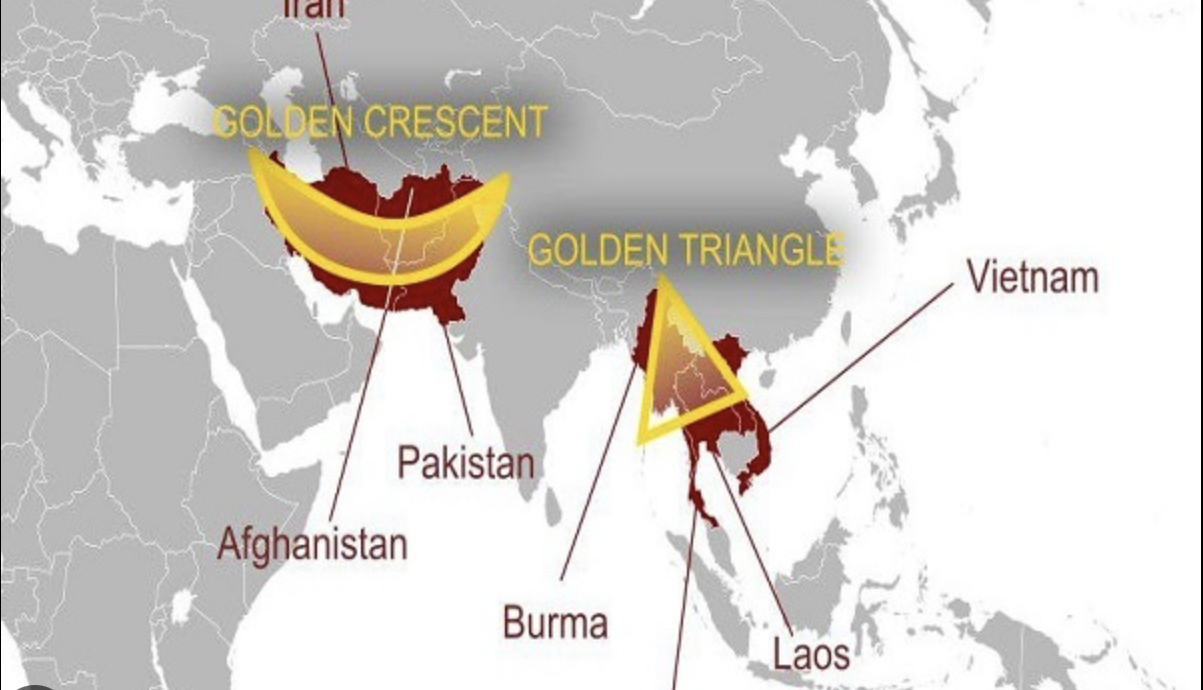India's proximity to the Golden Crescent and the Golden Triangle has made it vulnerable to the trafficking of drugs and narcotics. The flow of illegal drugs from the two fronts, that is the North Western and the North Eastern side leads to violation of national security which is the foremost concern of the country now. India is sandwiched between the Golden Triangle and the Golden Crescent which is why it is vulnerable to the trafficking of drugs. India had earlier reported a substantial increase in seizures of amphetamine-type stimulants, most of which are suspected to be methamphetamine. The reasons behind the spike were suspected to be increased trafficking across the Golden Triangle and the increased use of maritime trafficking routes along the Andaman Sea, crossing Indian territorial waters.
History of the Golden Crescent?
The Golden Crescent is much older than its counterpart in the region. The Golden Triangle began as an opium-producing entity during the 1980s, the Golden Crescent has been doing the same since the 1950s. The Golden Crescent’s Opium production saw a sudden and sharp fall during Operation Enduring Freedom, the USA’s retaliatory invasion of Afghanistan following the 9/11 attacks. Opium production fell by almost 90% in 2001.
The years post-2002 saw opium production come back on track owing to the political instability in Afghanistan. In 2007, the Golden Crescent produced more than 8000 tons of the world’s 9000 total tons of opium, effectively making it a monopoly. The world and the international community have not remained negligent and have been adamant in their efforts to crack down the opium production. However, despite these efforts in cracking down on the illegal drug trade only 23.5% of the total products distributed worldwide are seized. Most of the products seized, about 97% of them, are made in the Middle East. Although Afghanistan is the major producer of opiates and heroin in the Golden Crescent, most of the seizures are made in Iran, its western neighbour.
Tracing the routes of the Golden Crescent
The Golden Crescent primarily operates through two routes, the Northern and the Southern routes. Through the ‘Northern Route’, opium and heroin are trafficked to the Russian Federation by way of Tajikistan and Kyrgyzstan. As a result, Russia is facing an epidemic of a fast-growing HIV population with over 50% of known cases resulting from intravenous drug use.
Through the ‘Southern Route’, heroin travels from Afghanistan through Pakistan and Iran by sea to South Asia, Africa and Oceania region. The Indian Ocean is a favourite route among drug smugglers as the vast expanse of the Indian Ocean Region makes it difficult for authorities to patrol the region. In order to overcome this hurdle, the Columbo Declaration was adopted to enhance cooperation among the nations of the Indian Ocean Region. Along with supplying the huge Asian and European markets, Afghan opioids have greatly destabilised the region by fulfilling the demand of its neighbouring countries. Both Iran and Pakistan are facing a drug addiction epidemic with officials of both countries proclaiming it a national disaster.
Why was the Thar Desert used to smuggle drugs?
It was earlier used as a route of supply of opium from Malwa to Karachi in the 1980s and also was a traditional route in the Chinese Colonial Era. The desert is a vast barren piece of land is poorly guarded and has a low-security level. The closure of the Balkan passage through Iran after the Iran-Iraq war forced the rerouting of the supply chain from India. The Khalistan issue in the 1980s aggravated drug trafficking in India in the Punjab region.
How is India affected by the Golden Crescent?
India is geographically situated between the Golden Triangle and the Golden Crescent. Given India’s geographic proximity to these hubs where drug flow thrives, it makes it difficult to negate the fact that large amounts of heroin and opium pass through the Indian heartland. The effect of this has been devastating, to say the least, and nowhere has it been more evident than in the Indian state of Punjab.
Though Punjab does not grow opium or heroin, the region consumes about Rs. 7500 crores worth of drugs every year. The drug cartels enter India, mainly through the Golden Crescent route. Punjab is both a market as well as a transit point for drugs smuggled from the Golden Crescent and Golden Triangle, thus worsening an already precarious situation. Amritsar, Tarn Taran, Ferozepur and Fazilka districts sharing the border with Pakistan are part of the drug smuggling route which the Pakistan or Afghanistan-based drug smugglers use to move their consignments.
Rehab centres, anti-narcotic drives and heavy police crackdown on drug smugglers have to an extent stemmed the flow of narcotics, but the volume of the drugs coming in means that it is a difficult fight. Until more innovative measures are enacted it will be an uphill task to completely eradicate the drug menace from Indian soil.
While certain steps have been taken in this regard to counter the drug menace India must also address the problem on the demand side. Addiction should not be seen as a character flaw, but as an ailment that any other person could be struggling with. Therefore, the stigma associated with drug taking needs to be reduced. Society needs to understand that drug addicts are victims and not criminals. Certain crop drugs which have more than 50% alcohol and opioids need to be contained. Strict action is required from police officers and the excise and narcotics department to curb the problem of drug menace in the country. Education curriculum should include chapters on drug addiction, its impact and also on de-addiction. Proper Counselling is another alternative.
